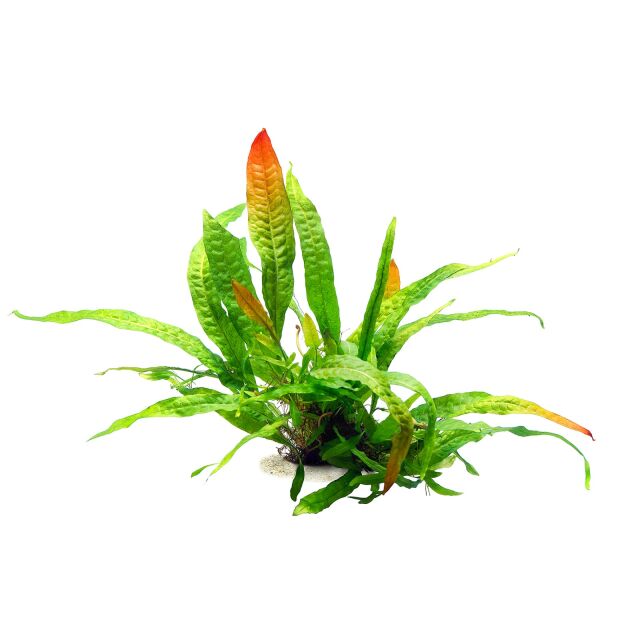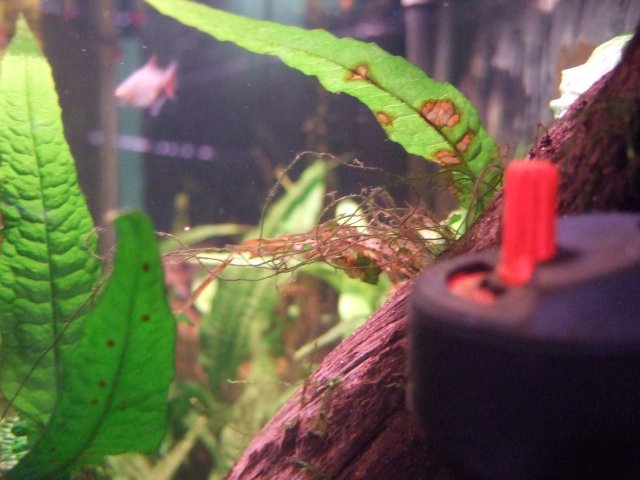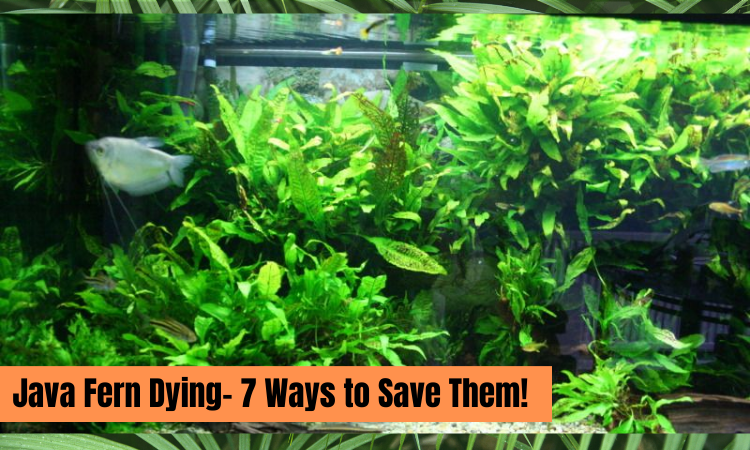Java ferns being a low-tech plant is the primary reason for choosing this plant. But how unlucky one would have to be to find it dying.
Yeah, we feel that. In fact, no matter how easy to maintain a plant you have, at the end of the day it might fall apart. And the most amazing part is that, when it happens, you can still save it.
So, what to do if Java Fern Dying?
Java Fern dying can be solved by Iron supplements, essential macronutrients, and proper lighting. Plus increasing the CO2 level and removing algae also helps. It dies due to lack of nutrients, CO2, improper planting, etc.
These were just a summary of what can be done to save them. There are many more factors that need consideration to step forward in saving them.
Now, let’s dive right into the details-
Is Your Java Fern Really Dying?

Source: https://www.2hraquarist.com/
Now the question comes if your java fern is really dying or not. Well, sometimes people tend to get afraid the moment they see their fern turning yellow, brown, transparent, etc. But we need to clear it out.
So let’s see if these colors actually mean they are dying or not-
Seeing Java Fern Black Spots
Java Ferns are often seen to have black spots on them. These spots are not always a bad sign. This can be java fern propagation too. Often java fern has young plants sprouting from these black spots. So don’t get afraid upon seeing black spots on them.
However, if no new plants are sprouting from these black spots, they are likely to die. So the best bet is to wait a day or two to see if they are sprouting new plants or not.
Turning Yellow
Java fern is seen to turn yellow and have pinholes in it. When it turns yellow, it can be gained back to green. It occurs due to a lack of necessary nutrients. It’s caused by nitrogen, iron, potassium, or magnesium deficiency.
The first thing to do here is to make sure the rhizomes are not covered anyhow. If they’re not exposed to light, the leaves can turn yellow.
If there are both new and old leaves turning yellow, it’s facing nitrogen deficiency. If only the older leaves are turning yellow, this is phosphate deficiency.
Here dead patches are seen added to older yellow leaves. Thirdly, it’s facing potassium deficiency if there are yellow pinholes on it. And if the entire java fern has turned yellow there’s iron deficiency.
So according to which nutrient deficiency your plant is facing, use those supplements. For example, use iron supplements if you are facing iron deficiency. Here are our recommended supplements
| Image | Product | Price |
|---|---|---|
 | Seachem Flourish Freshwater Plant Supplement | Order Now! |
 | Aqueon Aquarium Plant Food | Order Now! |
 | API Leaf Zone Freshwater Aquarium Plant Fertilizer | Order Now! |
Turning Dark Green
Java ferns are seen to have dark green tips on their new leaves. There’s nothing to be worried about Java Fern turning green. This is just like having black spots. This is the indication of having new growth on these leaves.
But it happens due to another reason sometimes. And that is nitrogen deficiency. The way to understand it is to check for new growth on the green tips. If you see no new growth from the green tips and they are disintegrating, you need to up your nitrogen dosage.
An easy way to do this is by adding fertilizers. Here are our top nitrogen-filled fertilizer picks-
Turning Transparent
Java Fern turning transparent is a good sign. It just means that there are good growing conditions provided to your java ferns.
Actually java ferns love phosphate. And they can take up a lot of it. So when they turn transparent, there’s a lot of phosphates available in your tank.
Sometimes they seem to turn transparent when there’s an ample amount of light present. Plus there are many cases of turning transparent after installing a diffuser.
Turning Light/Pale
Java ferns turn pale/lighter than green due to a lack of macronutrients and nitrogen. This also happens if you have a high-tech tank. In that case, too much light exposure can cause the leaves to turn pale. They can’t cope up with the growth and thus turn pale.
You can increase the dose of nitrogen for them to green up. However, if you want to increase the macronutrients dosage, you should……
Turning Red

Source: https://www.aquasabi.com/
Java Fern turning red is caused due to excessive lighting and temperature. This high temperature can affect the salinity as well.
However java fern turning red doesn’t mean that they are dying. When you have enough nutrient content, they have the potential to turn red in presence of excessive lighting and high-temperature conditions.
If you want to get rid of java fern turning red, try tuning down your lighting system. This will help them green-up. And also prevents the new leaves from turning red.
However, if you want to be sure about your light intensity, then it’s always better to check the actual lumen. Sometimes, the plant size to light number might not work out. So, here’s our recommended lumen meters-
Can Java Fern be Saved After Turning Brown/Black?
Yes, it can be saved. Java Fern turns black/brown when there’s something wrong in the ambiance it’s growing in. There might be problems in the nutrient level, light exposure, improper planting, etc.
These problems can be easily solved. If these problems are corrected, the leaves will turn back to their green state.
Why is Java Fern Dying? [Reasons & Solutions]
Java fern dies following 3 transition periods. First, they turn brown and then black.
Finally, the leaves start to dissolve or melt. This results in the death of the plants.
Let’s have a broader look at these phases below-
Phase 1: The Brown Phase

Source: https://www.aquariacentral.com/
In this phase, the leaves start to lose their green color. They gradually turn into brown leaves.
Now, this browning might be full leaf browning or some portions of it. Whenever the leaves start turning brown, they are seen to shrink a bit. They don’t remain as vigorous as before.
Let’s see what causes the leaves to become brown and what can be done to prevent it-
Reason 1: Lack of Nutrients
Browning of leaves can occur due to a lack of nutrients. Since java fern is not planted on a substrate, leaves acquire nutrients from the water.
In most cases, it is Iron deficiency that causes the leaves to turn brown.
Solution: Use Iron Supplements
You should use iron supplements in your water in order to fill the iron gap. Iron is the nutrient that keeps the leaves green in java fern. If you are already using a nutrient package, make sure it has iron in it.
If you already have iron, check your water hardness. Most of the time leaf necrosis happens when the water is too soft(<4.0 dGH).
In this case, you can add Seachem Equilibrium to harden the water. Or Gh booster which can be easily made at home.
If your water is already hard enough and has iron too, Magnesium will do the trick.
Here’s a list of iron and Magnesium supplements we recommend-
- Reef Advantage Magnesium– contains no ammonia
- Monterey Granules Iron– corrects Iron deficiency
Reason 2: Lack of CO2
CO2 is not most essential for growing java fern. However, it is obviously beneficial to have CO2. It helps in boosting their growth.
Apart from the slow growth rate, the lack of co2 also causes the leaves to turn brown. That’s because CO2 helps in the photosynthesis of plants. They use the sun’s energy to break down sugar out of carbon dioxide and water.
So when there’s less co2, photosynthesis slows down. In the case of java fern, when the leaves turn brown it indicates a lack of co2 in them.
Solution: Increase CO2 Intake
You can increase CO2 intake artificially in the aquarium. You can make it at home using yeast.
CO2 output from yeast is sufficient to ensure the proper growth of the leaves. You can easily make a co2 reactor at home for supplying CO2.
Reason 3: Improper Planting
Java fern is such a plant that doesn’t need to be planted in a substrate. Here they are tied up with rocks or driftwood.
But the mistake most people make is planting them deep in the soil. This hinders the rhizomes from light exposure. This in turn makes the leaves brown.
Solution: Make Sure to Not plant in the Soil
What you need to do here is make sure they are not planted in the soil. This will hinder the rhizomes from getting light and thus turn the leaves brown.
The roots of the java fern need to be tied with rocks or driftwoods. For this, you’ll need zip ties or threads.
Here we are again to help you with some best-quality recommendations-
| Image | Product | Price |
|---|---|---|
 | KingLake Cable Zip Ties | Choose Now! |
 | YDSL 328ft (100m) Twist Ties | Choose Now! |
In this way, the rhizomes are not covered in any way. Plus if your driftwood is not sinking to the bottom, don’t worry. Just wait till it comes to the place you wanna tie java fern to.
Reason 4: Temperature
Temperature is an important factor when it comes to the leaves becoming brown. If the temperature is high it causes the leaves to become dry and turn brown.
Solution: Ensure the Right Temperature
In order to have the right temperature, make sure it doesn’t exceed 75 degrees F in the day. And at night, the Temperature should not exceed 65 degrees F. Thus, you should regularly check the temperature of the aquarium to be on the safe side.
Phase 2: The Black Phase
Source: https://barrreport.com/
Java Ferns turn black due to a couple of reasons. It’s not that they have brown spots on them. Rather the entire leaf starts to black. Let’s see why it happens-
Reason 1: Blue-Green Algae (BGA)
Java fern is very much vulnerable to algae accumulating on it. When there’s bad filtration in the tank, detritus tends to accumulate on it.
So, this makes algae form on the leaves. They feed on these detritus and create a black layer on the leaves.
Solution: Use Algae Eaters
In order to remove these algae feeding on your java fern, you can use API algae eaters. These algae eaters are very efficient in eating up these algae.
Another thing you can do is bleach wash the algae-affected plants. This will remove the algae in the presence of bleach.
For this, add 1 cup of bleach to 19 cups of water. After that, dip the java fern in the bleach solution for about 2 minutes. This will get rid of the algae from the ferns.
Reason 2: Disease From Other Plants
Java fern can catch diseases from other plants that are planted in the tank. It’s quite common in the case of java ferns.
Often, these diseases are based on fungus, bacteria, and algae too. We’ve already talked about how to get rid of algae.
So, let’s see what you can do when there are bacterial or fungal diseases in java fern.
Solution: Soak in Potassium Permanganate
In order to disinfect from other diseases, you’ll need a Potassium Permanganate solution.
So, take a water container according to your java fern height. Add water to it. After that, keep adding the Aquaetic Potassium Permanganate. Keep adding until the color of the water becomes dark pink.
Finally, soak java fern in the solution. Keep it there for 15 minutes and pull it out. Don’t forget to rinse it with dechlorinated water after pulling it out. Your java fern will be free of bacterial and fungal diseases.
Phase 3: The Melting Phase

Source: https://www.reddit.com/
Lastly, we’re gonna talk about the melting problem of java ferns. Here they don’t turn into any color, rather the leaves dissolve followed by shrinking. This can happen for a lot of reasons. Among them are excess light and nutrient deficiency.
Solution: Use Liquid Fertilizer
In order to get the right nutrition, you can get liquid fertilizer with essential micro and macronutrients.
Here’s a list of fertilizers that we recommend-
| Image | Product | Price |
|---|---|---|
 | Fluval Plant Micro Nutrient for Aquariums | Pick it Today! |
 | NilocG Aquatics Aquarium Plant Fertilizer | Pick it Today! |
Maintenance and Care
Now that you know all the problems and solutions relating to java fern dying. It’s time for some tips on their maintenance and care. These will prevent any unexpected problems regarding java fern. Let’s see-
- Plant/Replant Properly- It is to be noted that java ferns are never planted in the substrate. This will slow down their growth. And they will slowly die off. So make sure to tie them with rocks or driftwoods.
- Ensure The Water Temperature- 65°-75 ° F is ideal for java ferns. If the temperature exceeds this range, leaves are likely to turn brown.
- Choose the right Tank Mates- Java fern is compatible with a large number of fishes. They can be small and large too. That’s because it has a rough leaf surface. Compatible tank mates include Arowanas, Catfish, Cichlids, and others.
It’s important that you take proper care and maintenance of your java ferns. Proper care can reduce the probability of their death.
FAQs
Now we’ll be answering some of the most commonly asked questions about Java Fern.
How do I know if my Java Fern is dying?
Java fern does if it turns brown/black and no new leaves are sprouting from them. Plus if they shrink a lot in size, they are dying.
Does Java fern reduce nitrates?
Yes. Java ferns can reduce nitrates present in the aquarium. Their leaves absorb the dissolved nitrates in water.
Conclusion
This was all from us on Java Fern Dying. There were many confusing things we needed to address in our article. We tried to portray them as simply as we could. You are suggested to ensure if your leaves are actually dying changing color like they usually do.
Thank you for staying with us till the end. If you have any queries, feel free to comment down below.




